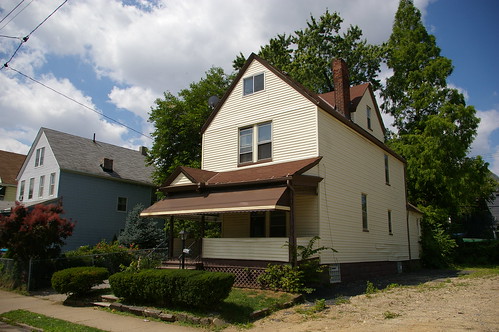
On Tuesday afternoon, Jay Gardner, Community Development Director at Fairfax Renaissance Development Corporation, was kind enough to show me through a certain historic house, located at 2266 East 86th Street, in the Fairfax neighborhood of Cleveland, Ohio. Writer, poet, and playwright Langston Hughes lived alone in an attic apartment here from 1917-1919, during his junior and senior years at Central High School.
Hughes' stepfather and mother had left for Chicago, in search of work, leaving him behind. During his residence here, he met Russell and Rowena Jelliffe, founders of Karamu House, a settlement house where Hughes taught art to children, and where some of his plays would later premiere. It is during his residence at this house that he began to really pursue writing - he joined the staff of the high school literary magazine, where some of his first writings were published.
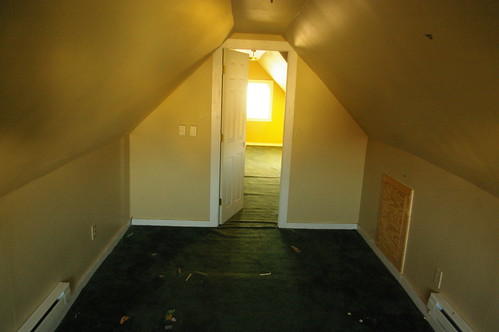
The attic, which consists of two rooms, retains very little, if any, of the physical fabric present when Hughes called it his home. The trim and doors seen in this, the front room, are relatively recent, as are the electric baseboard radiators. When the house was built, this space was probably unheated - the rest of the house is heated by forced air. The joints near the peak of the ceiling have a slight jagged nature, consistent with amateur drywall work. The joints between the knee wall and the roof are relatively sharp, more consistent with work in drywall than plaster, further suggesting that the attic was (re)finished recently. The window in this room is a vinyl replacement.

The rear room in the attic is finished in a similar manner. A closet can be seen to the left. The joints strongly suggest use of drywall, as in the front room. The lack of symmetry suggests an attempt to use every bit of available space.

This view of the rear room, facing the front of the house, shows the closet, to the right. It is a recent addition, which, in addition to providing storage, encloses the chimney. The trim and closet doors are definitely recent. Due to the asymmetrical nature of the space, I expect that the small wall to the left was added later - opening it up would make the space feel a bit more open and comfortable - this was probably the builder's intent with the assymetrical shape of the room.
I suspect this room included a bathroom at some time in the past. The plumbing can be seen exiting the roof on the opposite side of the ridge from the two bathrooms. If there were only those two bathrooms, the vent ought to go straight up, which would have it exiting the roof a few feet on the other side of the ridge. The only logical reason for the location of the vent is to service a third floor bathroom.
It is not known if the bathroom was installed when the house was built or later. The floor of it would almost certainly have been wood, not tile. If it was added in the 1910s or 1920s, it would likely have included a claw-foot tub, a toilet, and a wall mounted sink.
If the third floor bathroom was not present when Hughes rented there, he would have bathed in the bathroom on the second floor. It was probably fitted with a claw-foot bathtub. The original window was much larger than the current one. It would have provided the bather a view of the back yard.
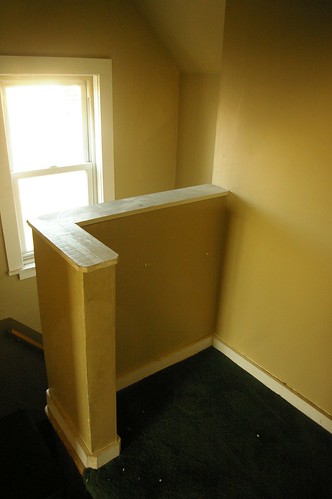
This railing makes the third floor space a bit safer. It appears to be later, showing the same style of trim as the rest of the third floor. The window in the background is a vinyl-clad replacement. The trim on this window, like the others on the third floor, appears recent, probably installed at the time the windows were replaced.
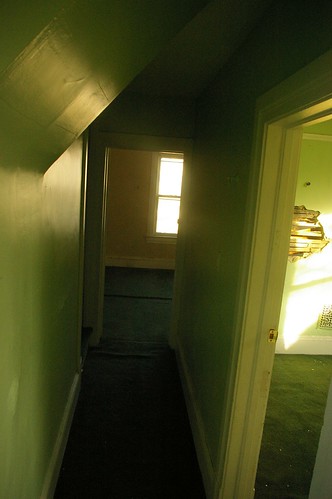
The second floor consists of three bedrooms and a bathroom, joined by a long hallway. To the left, at the end of the hall, are the stairs going up to the third floor. Behind the camera to the right is the third bedroom. To the left is the bathroom and the stairs to the first floor. The remains of a gas lamp can be seen on the wall, near the top of the doorframe in the foreground.

The damage to the plaster in this, the front bedroom, coupled with the damage on the corresponding wall in the middle bedroom, suggests that someone was trying to find something in the wall. It isn't near where one would expect to find plumbing, so it's unlikely that we'll ever know just what they were looking for. The baseboards and moulding around the door frame are original - it's unclear whether the trim near the top of the room is. Note the ornate furnace register grate on the wall.
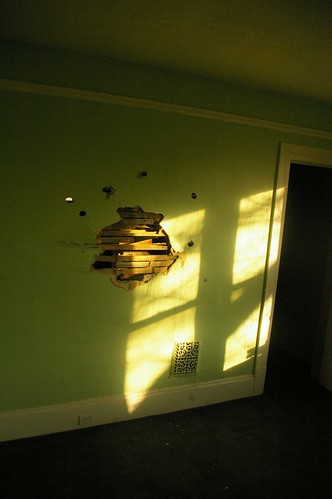
The center bedroom is in most respects similar to the front bedroom. A small closet sits in one corner.
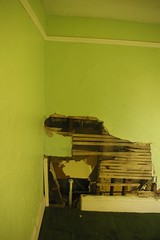


The rear bedroom is adjacent to the bathroom - the damage in the wall came from vandals removing the plumbing. The jog in the wall in the center photo is due to the presence of the chimney.
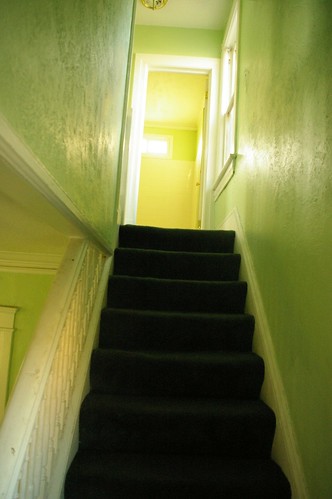
From a point halfway up the stairs, one can see the bathroom. It was completely remodeled at some point in the recent past.
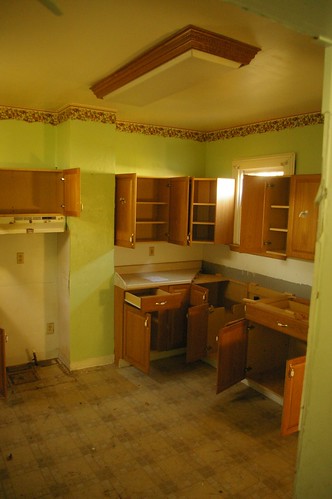
The kitchen is in a small addition at the rear of the house. As with many foreclosures, it has suffered some vandalism. The projection from the wall to the left is an old chimney. The window is a replacement - the original was considerably taller, but was shortened to fit in the sink. The original stove probably extended from the left edge of the chimney to the left wall.
I haven't been able to come up with an exact date for the construction of the kitchen. It was added on before 1936, as it is included on the floorplan on the property card dated October 23 of that year. Further, the property card does not mention a date for the house being remodeled, which suggests that it was not recent. In his first autobiography, The Big Sea, the only mention Hughes gives of his place of residence is this passage, on page 33:
I couldn't afford to eat in a restaurant, and the only thing I knew how to cook myself in the kitchen of the house where I roomed was rice, which I boiled to a paste. Rice and hot dogs, rice and hot dogs, every night for dinner. Then I read myself to sleep.

The dining room retains the original mouldings and trim. The wainscotting appears to have been added later.

From the dining room we can see the living room and stairs to the second floor. To the left, a doorway provides access to a half bathroom and the basement stairs.
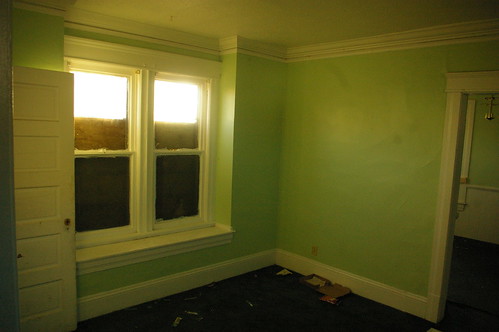
The living room is trimmed in a manner similar to the dining room. The moulding seems to include a picture rail.

This beautiful railing graces the staircase, making up the north edge of the living room.
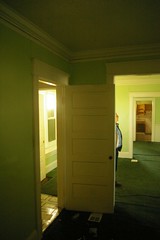
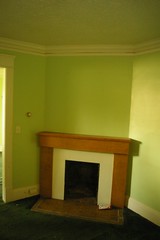
The den, at the front of the house, has a fireplace. The tile on the floor appears to be in good condition.
My attempts to learn more took me to the Cuyahoga County Archives, where I investigated the property cards, a set of documents created in two series, in the 1930s and 1950s, to document all the houses in the county, for tax valuation purposes. They detail the various amenities of each house, which allow us to see how they may have been changed over time.
Both property cards, dated October, 1936, and July, 1959, state that the attic was unfinished. There was a floor present, but that was it - the space was used for storage. There are a few ways to interpret this. One could take this information at face value. Or one could say, since this information was partially owner-reported, that the owner was trying to get the lowest possible tax-valuation. Another possibility is that the attic was partially finished, but the finish quality was such that, for the purposes of valuation, it was not counted as finished. The property cards also both state that there was only one bathroom, which is not what the physical evidence would suggest.
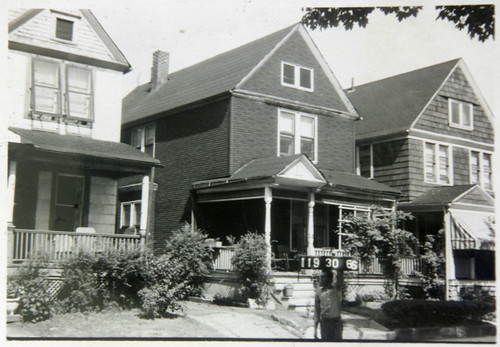
This photograph, taken in July, 1959, reveals a bit more, if perhaps not much of Langston Hughes' experience in the house. The house is the one in the center. It retained the slate roof and original half-round gutters at the time, and the porch had not been obscured by the massive aluminum awning. There isn't enough detail, alas, to tell anything about the attic windows. The siding has been covered by composite shingles.
Perhaps the most notable visual difference is the loss of the trim between the second or third floor. When the vinyl siding is removed, this will again be visible, providing the house with slightly better visual presence. One can see something of the character of the bay window on the side of the house, too.
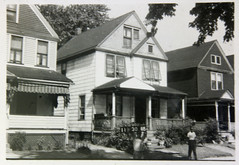
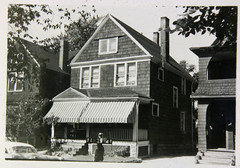
These two photographs of the houses on either side, now demolished, reveal a little bit more about this house, but not much.
I have to wonder how much this experience shaped Langston Hughes. Would he have spent so much time reading, writing, and learning, if he had been in slightly more comfortable surroundings? Would he have made so many important friendships? Would he have grown into the man he became otherwise?
This was Hughes house during a critical period in his life, when he started to really become a writer. I look forward to following the renovation of the house and to seeing what turns up.




This is really fascinating, especially your conclusion about how living in a different space might have shaped him differently. We *maybe* think about how living in a certain city or region might have shaped an author, or growing up with a certain type of family, but not so much about their literal physical surroundings.
ReplyDeleteAlso when I saw the attic bedroom pictures I said, "oooh", because that is exactly the kind of writing space I wanted (but didn't manage to find in our price range) when we were looking for a house.
(I guess what I'm trying to say is, when I don't become a famous writer I'm going to blame it on my house.)